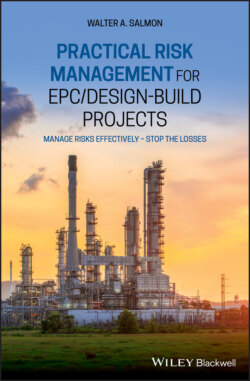Читать книгу Practical Risk Management for EPC / Design-Build Projects - Walter A. Salmon - Страница 32
3.2 Construction Project Hazards Abound
ОглавлениеThe sheer number of hazards that Construction Projects are surrounded by is enormous, and they exist in many different forms; for overseas Projects the list of hazards is much longer than for home-based Projects. Many of those hazards simply cannot be avoided – they are just part of the territory – and so the Contractor has to develop plans for ensuring that such hazards are not allowed to transform into regrettable events. For example, where work is taking place in confined spaces (such as inside tanks) it is essential that somebody is deputed to stay close by outside and is provided with appropriate rescue means/equipment in case the worker inside gets into difficulties. The following are just a few more limited examples of where Project hazards can be found.
1 Some hazards may threaten the Project's progress, such as delays in the engineering work, delays in the procurement work for key equipment and materials, construction delays, commissioning delays, and start-up delays. Hazards having such effects include, but are certainly not limited to, the following:an inadequate and/or inexperienced Design Team;a dramatic change in the economy leading to increased demand for products and consequent higher costs (requiring extra time to shop around for better prices);importation and transportation delays owing to bad management of the logistics support activities;inadequate or poor-quality labour resources (particularly in respect of local Subcontractors); andpoor quality control of construction work (leading to long lists of ‘Punch Items’ and the consequent late redoing of critical work).
2 In countries where the political landscape is unstable, there may be the potential for additional significant hazards:an armed attack on the accommodation camp or the worksite, thereby putting the security of personnel at grave risk;importation of materials, goods, and equipment becoming a major problem, due to problems with trade tariffs or arguments over import duties payable, or even due to the lack of newly-required ‘support’ documentation (especially when dealing with governmental authorities);the local communities blockading the worksite if they feel aggrieved at the perceived high numbers of foreign workers while the locals themselves do not have jobs; andcurrency exchange rates unexpectedly and dramatically moving in the wrong direction (from the Contractor's perspective).
3 There will be everyday hazards that impact the safety of the on-Site construction workers, such as working at height, operating heavy equipment, lifting heavy loads, working in deep trenches or in confined locations, pressure testing of pipework and equipment, energising high voltage electrical equipment, etc. There could also be hazards that will impact the environment, such as spillages of toxic materials, chemical leakage into water systems, etc. These all fall under the domain of a Contractor's Health, Safety, and Environmental (HSE) Management Department, in many of which very sophisticated procedures and routines are employed nowadays. Top priority must always be given to safeguarding individuals from harm, while at the same time protecting the environment. Thus, since these standard day-to-day risks should already be competently managed by the Contractor's designated HSE personnel, those risks are not the direct focus of this book.
The hazard situation for construction Projects will also be subject to change over time. Items that were previously discounted as being of no significance may therefore become elevated to a critical status later. On the other hand, items viewed as being potentially dangerous to people or the Project may not materialise into actual problems. For this reason, it is essential for key personnel to be designated as part of a specialised team (the Risk Assessment Team) made responsible for continuously monitoring the changing risk situation, re-assessing the hazards as the Project progresses, and putting in place effective mechanisms for mitigating the principal perceived risks wherever possible. Brady envisages that the activities of the Risk Assessment Team will include subsequently reviewing the risks after commencement of the implementation work to aid adjusting the controls (i.e. the mitigation measures for the risks) in the light of the knowledge gained.1
